As many readers of ElectronicsCooling are aware, there is a growing interest in the electronics cooling community in the possible use of liquid cooling. This interest is, of course, due to the trend of increased heat loads at chip, module, and system levels of packaging. The article by Mohapatra [1] in this issue of ElectronicsCooling provides a good overview of both dielectric and non-dielectric liquid coolants, including a tabulation of the thermophysical properties of various liquid coolants.
When selecting a coolant it is, of course, of interest to compare the heat transfer capability of candidate fluids. A convenient figure of merit with which to do this is known as the Mouromtseff number [2]. For single phase forced convection, Mouromtseff [3] found this figure of merit, Mo, to follow the form
 |
where ρ, k, cp and � represent the density, thermal conductivity, specific heat (at constant pressure), and dynamic viscosity of the fluid. The exponents a, b, d, and e take on values appropriate to the heat transfer mode of interest and the corresponding heat transfer correlation. It should be noted that the Mouromtseff number, unlike the more familiar Reynolds (ρ �V�D/�), Nusselt (h�D/k), and Prandtl (��cp/k) numbers, is not dimensionless. The significance of the Mouromtseff number lies in the fact that for flow over or through a given geometry at a specified velocity the liquid coolant with the largest Mouromtseff number will provide the highest heat transfer rate.
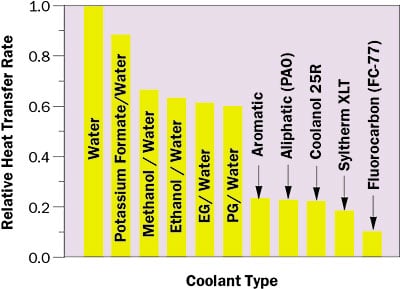 |
Figure 1. Comparative heat transfer rates (relative to water) for various liquid coolants (at 20°C) for fully developed, internal laminar flow.The Mouromtseff number for a given mode of heat transfer may be obtained by taking the corresponding heat transfer correlation and separating out the thermophysical property variables as a group. For fully developed, internal laminar flow, Nusselt number (h�D/k) is a constant so that the only fluid property affecting the heat transfer coefficient, h, is the thermal conductivity of the fluid. So, in this case the figure of merit, or Mouromtseff number, is the thermal conductivity of the fluid. Figure 1 shows a comparison of the heat transfer rates (relative to water) for internal laminar flow based upon the Mouromtseff number of each of the coolants (excluding Ga-In-Sn which is a liquid metal) listed in Table 1 of the Mohapatra article. The heat transfer rate relative to that of water for each of the liquids is simply obtained by calculating the ratio of the Mouromtseff number for each liquid to that of water, which in this case is simply the ratio of the thermal conductivities or
 |
For internal turbulent flow the heat transfer rate is dependent not only upon k, but also the other thermophysical properties of the fluid. In this case the Mouromtseff number is given by (3)
 |
As before the heat transfer rates relative to that of water may be estimated by calculating the ratio of the Mouromtseff number for each fluid to that of water. The comparative heat transfer rate for each of the fluids for turbulent internal flow is shown in Figure 2. It should be noted that both the heat transfer rates relative to water and in some cases the ranking of some of the fluids vis-�-vis one another have changed from that shown for the laminar flow situation.
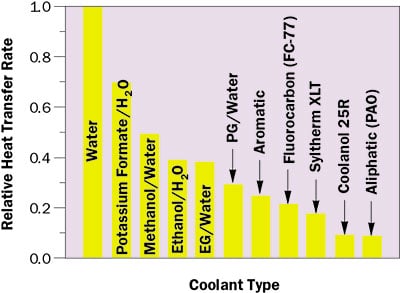 |
Figure 2. Comparative heat transfer rates (relative to water) for various liquid coolants (at 20°C) for internal turbulent flow.A similar comparison may be made for the heat transfer performance of these liquids in a developing, internal laminar flow regime. To do this it is necessary to select an appropriate heat transfer correlation. For the purposes of this article two heat transfer correlations reported by Liu and Garimella [4] will be used. These correlations are
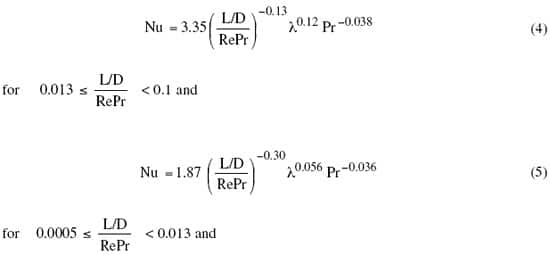
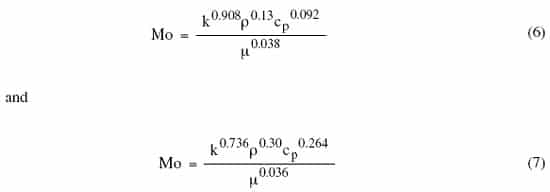
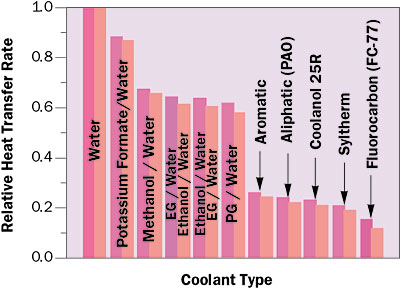 |
Figure 3. Comparative heat transfer rates (relative to water) for various liquid coolants (at 20°C) for developing internal laminar flow.The Mouromtseff number provides a useful figure of merit with which to compare the heat transfer capability of liquid coolant candidates. However, it is important to remember that the appropriate liquid coolant cannot be selected on the basis of heat transfer performance alone. Other characteristics such as those discussed in the Mohapatra article [1] must also be taken into account.
References
- Mohapatra, S.C., “An Overview of Liquid Coolants for Electronics Cooling,” Vol. 12, No. 2, February 2006.
- Bergles, A. E., “Evolution of Cooling Technology for Electrical, Electronic, and Microelectronic Equipment,” IEEE Transactions on Components and Packaging Technologies, Vol. 26, No. 1, March 2003, pp. 6-15.
- Bergles, A.E., and Bar-Cohen, A., “Direct Liquid Cooling of Microelectronic Components,” Advances in Thermal Modeling of Electronic Components and Systems, Vol. 2, Bar-Cohen, A., and Kraus, A.D., eds., ASME Press, New York, NY, 1990.
- Liu, D. and Garimella, S.V., “Analysis and Optimization of the Thermal Performance of Microchannel Heat Sinks,” Proceedings of IPACK03, Maui, HI, 2003.










